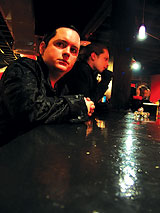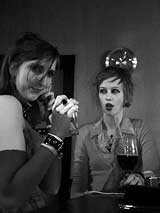
A Brave New Order: DJ Nareau seeks to redefine the goth stereotypes.
|
“I always feel like a new-age hippie-type saying this,” explains DJ Nareau (who, in a full-length black brocade jacket and inky-black hair, is among the least likely to be mistaken for a flower child), “but the purpose of doing these goth nights is to establish a community.”
The goth nights, hosted by The 5th Circle (the go-to for local underground events), have found a home for the past year or so at the Joli Rouge. Formerly Max’s Celebrity Deli, the two-floor club located on the corner of College and Walnut streets boasts dark windows, black paint and a stylized Jolly Roger on the sign. For the uninitiated, it’s intriguing, possibly intimidating, but definitely not mistakable as a makeshift community center.
“In Asheville, it’s not divided. The goths and hippies and freaks hang out together,” reports Madame Archel, a frequent guest at 5th Circle events.
“It’s absolutely community-oriented,” insists April, another goth-night regular. “I’ve been involved with the goth scene [in Asheville] for 12 or 15 years. People come and go, but the group who comes to this bar specifically are very tight knit.”
Beyond black nail polish

Shiny, happy people: Scene-stealers R. Maddox and Wanda Wright vamp at Joli Rouge.
|
The first question, of course, is “What is goth?” (or “the W.I.G. question,” as Madame Archel calls it). Wikipedia, although not the final authority, offers this succinct summation: “A contemporary subculture … It began in the United Kingdom during the late 1970s to early 1980s in the gothic rock scene, an offshoot of the post-punk genre.”
Music and fashion — usually incorporating a lot of black garb — help to define the culture, but goths are hardly a mass of Anne Rice-adoring clones.
“I’ve [been in a scene] probably since ’81,” reveals DJ Stowy, who also spins at 5th Circle events. “For me, I’ve always been an alternative music guy. I’ve always worn a lot of, well, not all black clothing because I don’t have black hair and black eyeliner like a lot of kids do these days. I’m a business professional, and when you see me during the day, I look like a regular person. But when I go out to this or that club, then I put on all the garb and we have a great time.” Garb, for him, means black SWAT pants, military boots and a band T-shirt.
“Back in the day, I used to draw little spider webs on my face, wear the eyeliner and paint my fingernails black,” he adds. “I don’t do that now that I’m an older guy, but the young kids still do. They dress it all up. I think I did it back then more for the shock effect.”
DJ Nareau weighs in: “Certainly for myself, and I think this is true for a lot of goth kids, [we] used to take ourselves a lot more seriously than we do now. In junior high and high school, there’s the whole depression thing and feeling super-important for freaking people out. [I] grew up a little bit and realized there’s more to life than freaking people out, but [I] still appreciate the aesthetic.”
Goth is about as misunderstood as it is difficult to define. The media has often characterized the wearers of black as being vampire worshippers, satanists, prone to violence and overwhelmingly depressed. “Children or teenagers fascinated by goths — a group fascinated by the darker side of human nature — have higher incidences of self-harm and suicide attempts,” announced Medindia, which bills itself as “Asia’s premier health portal”, earlier this year.
A few years ago, Cult News surmised, “Goth trendsetters include Addams Family star Christina Ricci and [Tim Burton] the director of Edward Scissorhands … But perhaps [goth’s] most disturbing icon is murderer Charles Manson. However, Manson’s face on patches seems to be as close as Goth enthusiasts come to destructive cult status.”
However, a Saturday at Joli Rouge turns up no Manson patches. Instead, the club offers a well-turned out clientele sipping selections from the fancy cocktails menu and talking in low voices over strains of vintage Robert Smith.
“One thing I really like about the goth and alternative scene is that the bars you would go to [are] always less violent,” DJ Stowy notes. “If you’d go to a booty bar or a country bar, by 2 a.m., there’s fights, but you’d go to an alterna-club and there would never be fights.”
Goth night at the Joli Rouge, though perhaps more leather- and fishnet-inclined than some of downtown Asheville’s other bars, seems downright civilized.
Morose at the mall
Mainstream culture has a continuing fascination with goth, as evidenced by the subculture’s cameo appearances in mainstream media. There was Winona Ryder’s PG-rated character in Beetlejuice, darker and edgier films like The Crow and Queen of the Damned (creepily, the starring actors in both films died during production) and Hot Topic, the omnipresent apparel purveyor that proudly calls itself “the loudest store in the mall.”
“There’s a lot of push back on [Hot Topic stores] in the goth scene,” DJ Nareau notes. “It’s kind of a joke. If you’re wearing a T-shirt that says ‘I’m weird’ and it’s made by a corporation that’s made hundreds of them, how weird are you?”
He adds, “One of the other things, speaking from my own experience, is a lot of goth kids get their clothes from Goodwill. Being young and poor [they] kind of manage to define their own style from picking up that kind of stuff. To be able to go to Hot Topic and be able to just pull something off the shelf kind of defeats the purpose.”
The first of the Hot Topic stores was opened in 1988, less than a decade after goth made its way from the U.K. to the U.S. Now the corporation has more than 600 stores selling mass-produced metal, indie, emo, punk and goth-wear, and major-label bands like Good Charlotte and Korn have sold their concert wear through Hot Topic.
“On the other hand, as much hate as there is for Hot Topic, I think there’s a place for it,” DJ Nareau muses. “It gives people who aren’t normally exposed to that kind of thing a chance to be exposed to it. I’d rather the scene continue to grow and thrive and be exposed to a lot of people than die off but remain somehow ‘superior’ or something.”
For DJ Stowy, the store controversy is less important than the lack of good readymade club clothes. “Clothing stores these days are not as good as they used to be. You used to have Merry-Go-Round and all these great stores that had all these high-end products, and now the only thing we’ve got is [Hot Topic],” he complains. That’s all mainstream stuff. It’s all this stuff where straps are hanging from pants and I’m not into wearing anything like that, but the young kids do.”
Getting a handle on Evanescence
On the music front, you can’t open a recent magazine without reading about Evanescence front woman Amy Lee. With long black tresses, pale skin and a wardrobe of dresses culled from the closet of Wednesday Addams, Lee is touted as some sort of goth princess, albeit one with a major record deal.
“[Evanescence is] kind of exposing people in a more mainstream to similar music,” DJ Nareau allows. “At the same time, the intent of how genuine they are carries some weight, and it doesn’t seem like they’re that genuine. It seems like they’re [a] corporate boy-band kind of thing, out there to make money.”
As for what constitutes real goth music, the DJ points out that it’s an ongoing discussion. “I sort of have this philosophy that goth music is what gets played in goth clubs and goth clubs are places that play goth music,” he says. “There are a lot of bands that don’t consider themselves to be goth, like The Cure or Sisters of Mercy, who are clearly iconic goth bands.”
“Goth and industrial have always been hand in hand,” DJ Stowy weighs in. “The skinheads have always come to our events because they can’t hear their punk music anywhere else. When I think of goths, I think of a very peaceful type of people. An industrial person is into more of a hard edge. If you’re going to go pure goth, it’s more of a slower, melodramatic music, some of it very hard to dance to. So usually, when you have an event, it’s a goth and industrial event.”
A 5th Circle set list includes Siouxsie and the Banshees, Switchblade Symphony, Dead Can Dance, Bauhaus, Concrete Blonde, Depeche Mode, Vive La Fete, Theatre of Tragedy, Nomad Project AV, Apoptygma Berzerk and Wolfsheim.
“I can pretty much guarantee you that if you looked at the set lists for 100 goth clubs, none of them would be playing Evanescence,” DJ Nareau promises.
Next stop: a softball team?
Both DJ Nareau and DJ Stowy came to Asheville from goth scenes in other parts of the state. “When my wife and I moved up [to Asheville] in ’98, we found that there was actually more of a scene here than there was in Raleigh, which really surprised us,” DJ Stowy remembers. “We were going to events at Metro [and then] at Shotzy’s … we were like ‘There’s actually a lot of people here who wear black!'”





Before you comment
The comments section is here to provide a platform for civil dialogue on the issues we face together as a local community. Xpress is committed to offering this platform for all voices, but when the tone of the discussion gets nasty or strays off topic, we believe many people choose not to participate. Xpress editors are determined to moderate comments to ensure a constructive interchange is maintained. All comments judged not to be in keeping with the spirit of civil discourse will be removed and repeat violators will be banned. See here for our terms of service. Thank you for being part of this effort to promote respectful discussion.